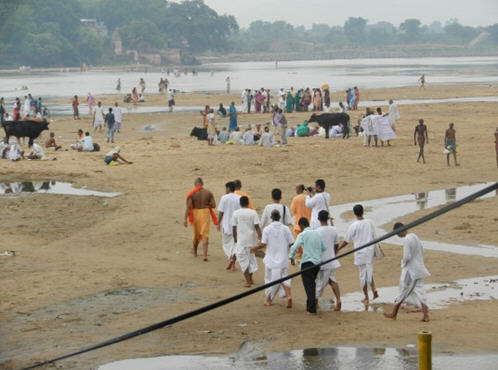
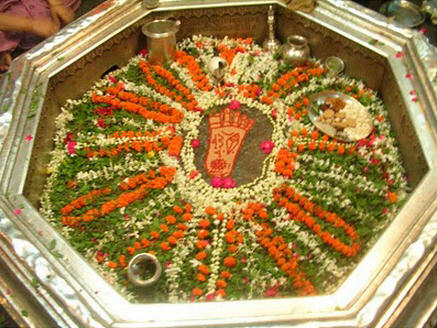
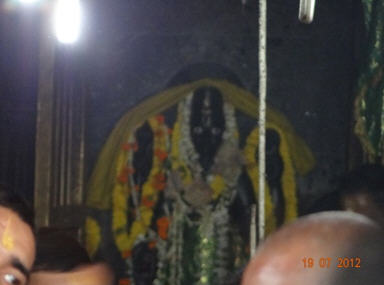

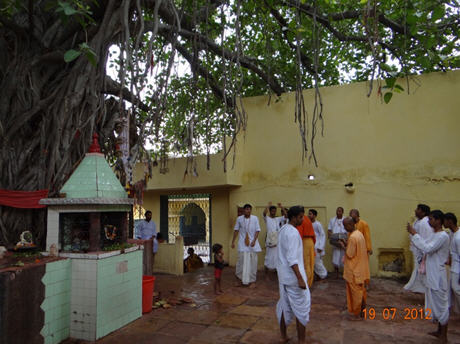
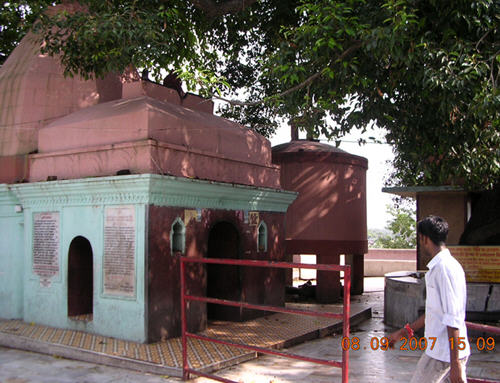

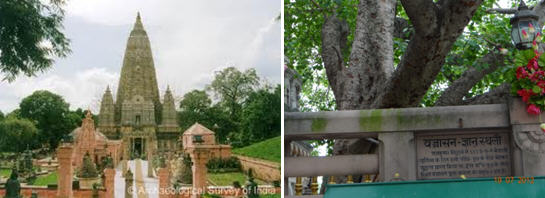
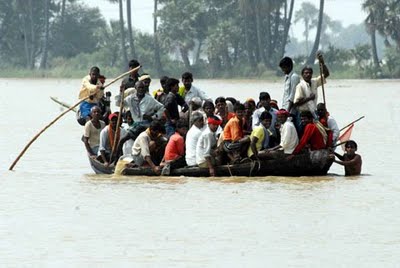









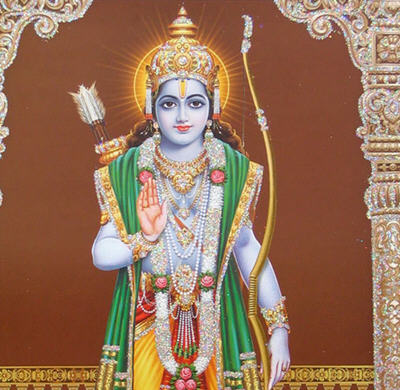
Lord Ram after being established as the king of Ayodhya was advised to performed sraddha for his father Dasharatha at the holy place of Gaya. Lord Rama accompanied by Sita and brother Laxman came to Gaya. As per the instructions of the sage who was going to perform sraddha, Lord Ram & Laxman went out to fetch the necessary ingredients. As auspicious time for the sraddha was passing by & Lord Ram- Laxman were nowhere in sight, The sage asked sita devi to do the pinda dana herself. She was asked to make balls (instead of grains) of sand from the river phalguni (phalgu river).
Sita devi’s performance of the pinda daan bore fruits when Dashrath Maharaj’s hand appeared from underground to accept the offerings made by her. Later when Ram & laxman arrived with the ingredients, sita informed them of the entire story. Lord Ram wanted some proof for this incident. Seeing a cow standing nearby , sita devi asked her to give witness . She also asked the river Phalguni & a Banyan tree to bear witness.
When cow & the river did not gave witness, sita devi became upset & cursed both of them cow was cursed to have her mouth always unclean due to continuous drool of saliva. And river was cursed to be waterless on its river bed. (River phalguni thus became phalgu which also means False River)
The banyan tree ,however, gave witness. Sita Devi became pleased & offered it the blessings of becoming immortal & never shred its leaves throughout the year.This tree is today called as Akshay Vat.(immortal banyan)
Gaya dham is located in indian state of Bihar.

Narada Muni narration to Sanatkumar . (GAYA Mahatmyam – Agni Puran)
Brahmaji once while engaging in activities of creation created a personality named Gayasur.Gayasur went on to perform severe penance on the mountain Kolahal.Indra became afraid of losing his position. So he along with all demigods approached Lord Brahma for help.Brahma unable to decide,sought the advice of Lord Shiva. Under the guidance of Lord Shiva – All demigods including Lord Brahma & Shiva went to Lord Vishnu for help.
Lord Vishnu being pleased with the prayers offered by demigods agreed to help them. He told all of them to go to the place where Gayasur is performing Tapasya. Lord Vishnu then riding on the Garuda reached mountain Kolahal.Touching his Counchshell on Gayasur’s head ,Lord Vishnu requested him to ask for some boon.
Gaya asked for an unique boon that whoever touches him (No matter he belongs to any caste or race or whether he is qualified or not) shall get immediately purified & achieve liberation in this very life. Lord Vishnu granted him the boon & thus stopped him from doingfurther tapasya.
As Indra’s problem got solved, it was Yamaraj who was put in to problem due to this boon.
HOW is that? .From the day the boon was conferred, all living entities just by mere sight or mere touch of Gayasur were getting qualified for liberation. No matter who the person was , would get elevated to Vaikuntha. This happened on such a large scale that literally the Hellish planets became empty.
With this new kind of problem, Yamraj along with all demigods approached Lord Vishnu again. Lord Vishnu arranged an unique plan to solve the issue ultimately .He instructed Lord Brahma to proceed with this new plan ahead.

As per the plan, Lord Brahma approached Gayasur. Gayasur became very happy at the sight of such an elevated personality Lord Brahma (His own father). Gayasura asked whether he could be of some help. Brahma informed that he is going to perform a big yajna & that he is looking for a purified place on earth todo this yajna. Unable to get such a place , Lord Brahma informed him that Gayasur‘s very body is purified by Lord Vishnu‘s boon & can be the best place for performing Yajna. Happy at this opportunity, Gayasur agreed for the proposal.
Gayasur lay down on the ground with his head facing east. A big yajna was performed on the huge body of Gayasur . On the completion of yajna , all demigods took ceremonial bath. Gayasur now decided to get up. As his body was shaking, as per the plan of the lord Vishnu, Yamraj placed a huge rock called as Dharma-sila on the body of Gayasur .When it was done, all the demigods placed their feet on the sila from all sides to make it stable. However the stone still kept shaking due to the power of Gayasur . Finally Lord Vishnu came & placed his 2 lotus feet on the centre of the Dharma- sila & the stone got stabilized, Gayasur thus got stuck beneath the stone.
Lord Vishnu as Gadadhar had appeared there standing by holding his gada (mace) . Lord Vishnu then spoke to Gayasur to ask for more boons underneath from the stone.Gayasur asked from Lord Vishnu that Lord along with all demigods remain residing on this huge stone rock till the end of creation. He asked from Lord to name the place “GAYA” after him & that it becomes a famous holy place. He further asked that anyone who bathes, offers pinda, offers charity will get benefited & purified immensely more than any other holy place. And that by taking Lord Vishnu’s darshan as Gadadhar , they will be further purified of all accumulated sins. Anyone who performed pinda dan & sraddha for his forefather here, the deceased ancestor will be absolved from all his sins & will get placed in his next life in Brahmaloka .
Further account explains theorigin of Dharma Shila (Rock) kept on the Gayasur. She was the daughter of Yamaraj herself of the name ‘Dharma Vrata’. Later she got married to the great sageMarichi(son of Brahma). She became stone on account of being cursed by her own husband. Once, while she was serving her sleeping husband by pressing his legs, Lord Brahma (her father- in – law) appeared in the hermitage . She was unable to decide whom should she serve now- should she leave her sleeping husband & welcome father – in – law or should she continue her serving. At this point, using her intelligence, she decided to welcome Lord Brahma. Unable to see his wife near him pressing his legs, Marichi became very disturbed & cursed his wife to become a rock as she was stone hearted in not rendering proper service. Dharmavrata was unhappy hearing this curse , so she too cursed her husband that he will soon offend Lord Shiva & will be cursed by him. Later both repented at their mistakes. So then both husband &wife now started doing tapasya to overcome their mistake.
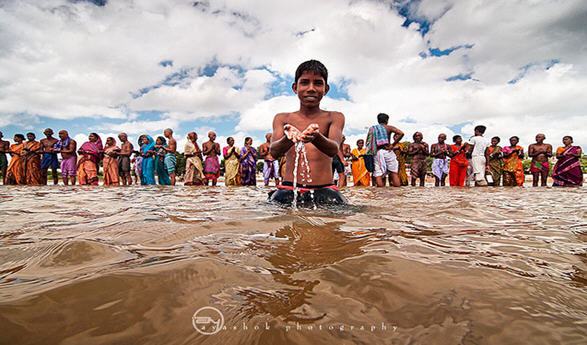
Dharmavrata’s intense tapasya became a topic of concern for all demigods. They all came to her. She asked them to nullify this curse. Demigods informed that curse given by great sages can never be nullify as each curse has a divine result in later part of life. Understanding this , Dharmavrata asked that as a stone she could become one of the most holy stones & that all the demigods may one day reside on her & people perform pious activities on her.
It is well known through different vedic scriptures that Lord Krishna, Lord Ram, Lord Nityananda, Lord Gauranga, Lord Balaram, Five pandavas, Bhisma, Bhaktivinod Thakur,etc, visited and offered pinda daan here. On his preaching tour, Srila Bhaktisiddhant saraswati Thakur also went to Gaya and opened a centre too.